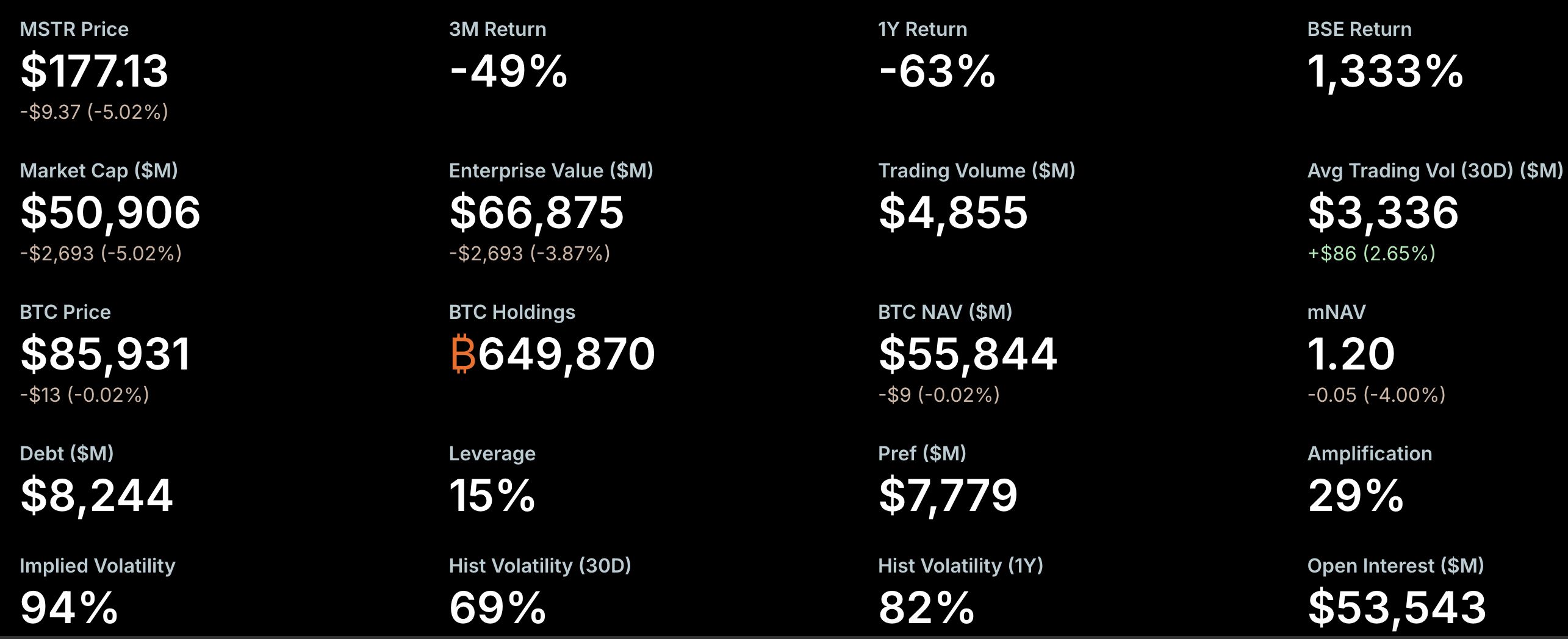MicroStrategy Faces Cash Crunch as Bitcoin Treasury Model Encounters Market Trust Test
Author: Nancy, PANews
Original Title: MicroStrategy Faces a Confidence Test: Nasdaq Delisting Risk, Motivation for Selling Coins to Buy Back Shares, Executive Sell-Offs
The crypto market is in turmoil, with Bitcoin's weakness dragging down the overall market, accelerating the clearing of bubbles and making investors tread carefully. As one of the key indicators in the crypto space, leading DAT (Digital Asset Treasury) company MicroStrategy is facing multiple pressures: a sharp narrowing of mNAV premiums, reduced coin hoarding, executive stock sell-offs, and the risk of index delisting, all severely testing market confidence.
MicroStrategy Faces a Crisis of Trust, Possible Index Delisting?
Currently, the DAT sector is experiencing its darkest hour. As Bitcoin prices continue to fall, the premium rates of several DAT companies have dropped sharply across the board, stock prices remain under pressure, accumulation actions have slowed or even stalled, and their business models are facing a survival test. MicroStrategy has not been spared, falling into a crisis of trust.
mNAV (market net asset value multiple) is one of the key indicators for gauging market sentiment. Recently, MicroStrategy's mNAV premium has rapidly contracted, at one point approaching the critical threshold. According to MicroStrategyTracker, as of November 21, MicroStrategy's mNAV was 1.2, having previously fallen below 1. Compared to its historical high of 2.66, this is a drop of about 54.9%. As the largest and most influential DAT company, the failure of MicroStrategy's treasury premium has triggered market panic. The underlying reason is that the decline in mNAV weakens financing ability, forcing the company to issue shares and dilute existing shareholders, putting further pressure on the stock price and causing mNAV to fall further, creating a vicious cycle.

However, NYDIG Global Head of Research Greg Cipolaro points out that mNAV has limitations as an indicator for evaluating DAT companies and should even be removed from industry reports. He believes mNAV can be misleading because its calculation does not take into account the company's operating business or other potential assets and liabilities, and is usually based on the assumption of outstanding shares, not including unconverted convertible debt.
Poor stock performance has also raised market concerns. According to MicroStrategyTracker, as of November 21, MicroStrategy's total market capitalization of MSTR shares was about $50.9 billion, already lower than the total value of its nearly 650,000 bitcoins held (average holding cost $74,433), which is $66.87 billion. This means the company is experiencing a "negative premium" in its stock price. Since the beginning of this year, MSTR's stock price has fallen by 40.9%.
This situation has sparked concerns about its potential removal from the Nasdaq 100 and MSCI USA indices. JPMorgan predicts that if global financial index provider MSCI removes MicroStrategy from its stock indices, related outflows could reach $2.8 billion; if other exchanges and index compilers follow suit, the total outflow could reach $11.6 billion. MSCI is currently evaluating a proposal to exclude companies whose main business is holding Bitcoin or other crypto assets, and where such assets account for more than 50% of their balance sheet, with a final decision to be made by January 15, 2026.
However, for now, the risk of MicroStrategy being removed is relatively low. For example, the Nasdaq 100 index adjusts market capitalization on the second Friday of December each year: the top 100 are retained, those ranked 101–125 must have been in the top 100 the previous year to stay, and those beyond 125 are unconditionally removed. MicroStrategy remains in the safe zone, ranking in the Top 100 by market cap, and recent financial reports show solid fundamentals. In addition, several institutional investors, including the Arizona State Retirement Fund, Renaissance Technologies, Florida State Pension Fund, Canada Pension Plan Investment Board, Swedbank, and the Swiss National Bank, all disclosed holdings of MSTR shares in their Q3 reports, which has also supported market confidence to some extent.
Recently, MicroStrategy's pace of accumulation has clearly slowed, which the market interprets as "running out of bullets," especially since its Q3 report shows cash and cash equivalents of only $54.3 million. Since November, MicroStrategy has accumulated a total of 9,062 bitcoins, far less than the 79,000 accumulated during the same period last year, though this is also affected by the rise in Bitcoin's price. This month's accumulation mainly comes from last week's latest purchase of 8,178 BTC, with other transactions mostly involving several hundred bitcoins.
To supplement its funds, MicroStrategy has begun seeking financing in international markets and launched a new financing instrument, perpetual preferred shares (which require high dividends, 8-10%). Recently, the company raised about $710 million by issuing its first euro-denominated perpetual preferred share, STRE, to support its strategic layout and Bitcoin reserve plan. It is worth noting that, as of now, the company has six outstanding convertible bonds, with maturities between September 2027 and June 2032.

Additionally, internal executive movements have also drawn market attention. MicroStrategy disclosed in its financial report that Executive Vice President Wei-Ming Shao will leave on December 31, 2025, and since September this year, he has sold $19.69 million worth of MSTR shares in five transactions. However, these sales were conducted under a pre-arranged 10b5-1 trading plan. According to SEC rules, a 10b5-1 trading plan allows company insiders to trade shares under pre-set rules (specifying quantity, price, or schedule), thereby reducing the legal risk of insider trading.

Multiple Analyses Suggest Debt Risk Is Exaggerated, High-Premium Investors Under Significant Pressure
In the face of bearish sentiment in the crypto market and multiple concerns about the DAT business model, MicroStrategy founder Michael Saylor reiterated the "HODL" philosophy, expressing continued optimism about the recent drop in Bitcoin's price and a bullish outlook for the future. He even emphasized that unless Bitcoin falls below $10,000, MicroStrategy will not sell its holdings, aiming to boost market confidence.
Meanwhile, the market has analyzed MicroStrategy from several perspectives. Matrixport points out that MicroStrategy remains one of the most representative beneficiaries of this Bitcoin bull market. The market has long worried about whether the company would be forced to sell its Bitcoin holdings to repay debt. From the current asset-liability structure and debt maturity distribution, Matrixport judges that the probability of being forced to sell Bitcoin to repay debt in the short term is low and is not the main risk at present. The greatest pressure is currently on investors who bought in at high premiums. Most of MicroStrategy's financing occurred when the stock price was near its historical high of $474 and per-share NAV was at its peak. As NAV gradually fell and premiums compressed, the stock price also dropped from $474 to $207, causing significant unrealized losses for those who entered at high premiums. Compared to the current round of Bitcoin's gains, MicroStrategy's current stock price has clearly pulled back from previous highs, making its valuation relatively more attractive, and there are still expectations of being included in the S&P 500 index in December.
Crypto analyst Willy Woo further analyzed MicroStrategy's debt risk and expressed strong skepticism about it being liquidated in a bear market. In a tweet, he stated that MicroStrategy's debt is mainly in the form of convertible senior notes, which can be repaid in cash, common stock, or a combination of both upon maturity. MicroStrategy has about $1.01 billion in debt maturing on September 15, 2027. Woo estimates that to avoid having to sell Bitcoin to repay debt, MicroStrategy's stock price at that time must be above $183.19, roughly equivalent to a Bitcoin price of about $91,502.
CryptoQuant founder and CEO Ki Young Ju also believes that MicroStrategy's probability of bankruptcy is extremely low. He bluntly stated, "MSTR would only go bankrupt if an asteroid hit the earth. Saylor would never sell Bitcoin unless shareholders demanded it, and he has repeatedly emphasized this publicly."
Ki Young Ju pointed out that even if Saylor sold just one Bitcoin, it would shake MSTR's core identity as a "Bitcoin treasury company," triggering a double death spiral for both Bitcoin and MSTR's stock price. Therefore, MSTR shareholders not only hope that Bitcoin's value remains strong, but also expect Saylor to continue using various liquidity strategies to ensure that MSTR rises in tandem with Bitcoin's price.
Addressing market concerns about debt risk, he further explained that most of MicroStrategy's debt is in convertible bonds, and not reaching the conversion price does not mean liquidation risk. It simply means the bonds need to be repaid in cash, and MSTR has multiple ways to handle upcoming debt maturities, including refinancing, issuing new bonds, obtaining secured loans, or using operating cash flow. Failure to convert does not trigger bankruptcy; it is simply a normal debt maturity event and unrelated to liquidation. While this does not mean MSTR's stock price will always remain high, the idea that they would sell Bitcoin to boost the stock price or go bankrupt as a result is completely absurd. Even if Bitcoin fell to $10,000, MicroStrategy would not go bankrupt; the worst-case scenario would be a debt restructuring. In addition, MSTR could also choose to use Bitcoin as collateral to raise cash, although this would bring potential liquidation risk and would therefore be a last resort.
Disclaimer: The content of this article solely reflects the author's opinion and does not represent the platform in any capacity. This article is not intended to serve as a reference for making investment decisions.
You may also like
Why the plunge was even more severe than the market expected
System uncertainty and pressure are increasing.

How does the leading player in perpetual DEX view the future trend of HYPE?
If you believe that the trading volume of perpetual DEXs will continue to grow, then HYPE is one of the purest and most leveraged ways to capture this trend.

ETH Plummets and Rebounds: A Market Baptism Amidst the Storm
Bitcoin market reshuffle: who is selling?

